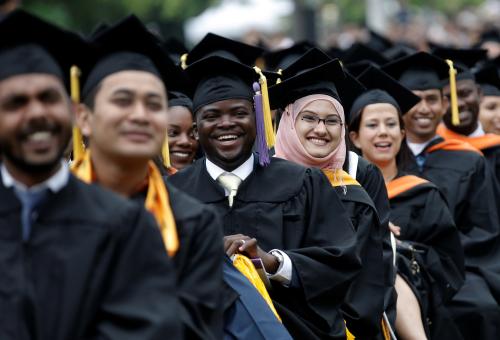There is currently a great deal of interest in the potential of college subsidy programs to increase equitable access to higher education and to reduce the financial burden on college attendees. While colleges may be subsidized in a variety of ways, such as through grants to institutions, in our latest Brookings report, we focus on college subsidy programs that directly reduce or eliminate tuition, fees, or other educational expenses incurred by students. A number of Democratic presidential candidates have advanced proposals for such programs, most notably the College for All Act of 2019 and the Debt-Free College Act of 2019.
However, because colleges and students differ in ways that are likely related to how subsidies might affect enrollment and because there is a large amount of interdependence between colleges and students over time, we cannot directly extrapolate from the relatively small number of existing large-scale subsidy programs that have been rigorously evaluated to predict the potential effects of programs with alternative specifications on enrollment patterns. Therefore, we turn to a computational modeling approach (“Agent-based modeling”) that allows us to explicitly simulate individual college and student decisions over time. Our model is grounded in a strong body of evidence about how students and colleges make application, admissions, and enrollment decisions.
We use the model to explore the potential impact of different prospective college subsidy programs on enrollment in selective colleges. We do this for two reasons. The first is that research suggests that attendance at these institutions has the strongest effect on later life outcomes (e.g. employment), especially for low-income students. And the second is that this set of colleges is unlikely to rapidly expand the numbers of students that they enroll because of their reliance on physical facilities and personnel. Less selective institutions, including community colleges and for-profit institutions, generally face fewer of these constraints and may more rapidly expand their supply of available seats in response changes in demand for college, and do so in ways that we are unable to reliably predict.

The graphic above describes the paths currently taken by high school students after they graduate or leave school. Some students do not pursue postsecondary education, some enroll in two-year colleges or in nonselective four-year colleges, and the rest enroll in four-year colleges that are at least moderately selective (ranging from less selective public institutions to highly selective elite colleges and universities). Our report focuses on the last category—and specifically, on how changes in the cost of college could change who enrolls in selective four-year schools.
The broadest subsidy program we consider would be available to all students attending four-year colleges that are at least moderately selective. Other subsidies are restricted to students with high observable academic achievement (a minimum high school GPA of around 3.0) or to those from low- or middle-income families, may only be used at in-state public colleges or at the least selective in-state public colleges, and are available to only 10% or 50% of qualifying students (comparable to a subsidy program that is offered on a state-by-state basis rather than nationally).
The outcomes that we focus on are enrollment effects of subsidy policies experienced by policy recipients. We calculate this as the difference in enrollment outcomes for students who are offered subsidies under a given policy condition and those experienced by the same population of students in “baseline” model runs (i.e. for the same set of students in the absence of active subsidy policies). The enrollment outcomes that we explore are:
- Whether students enroll in any selective college
- Whether students enroll in a selective college where enrollment is or would be subsidized
- Whether students enroll in an “elite” college (i.e. the top 20% of selective colleges)
In the following dynamic visualization, we present each of these outcomes for recipients overall as well as disaggregated by resource quintiles.

Our simulations allow us to observe how different college subsidy programs affect participating students’ enrollment in selective colleges. This is obtained by comparing simulations with the program active to ones where no programs are active (“starting values” give enrollment levels for analogous students absent a college subsidy program). We look at enrollment in any selective college as well as enrollment in two types of selective colleges: those that are subsidized by a specified program, and elite colleges (i.e. the top 20% of selective colleges). We present overall enrollment as well as enrollment disaggregated by family income quintiles.
Although there are many specific program effects that interested readers can view at their leisure, we wish to draw attention to several patterns that emerge.
- Effect sizes and directions. Subsidized college options attract students to apply and enroll in them, but they can also have indirect effects for these students: they change potential recipients’ application strategies (which colleges they consider and apply to) and in some cases shift attendance away from non-subsidized colleges (including elite colleges under many subsidy program formulations).
- >Resource quintiles. Generally, direct subsidy effects are greatest for higher-resourced recipients, while indirect effects tend to be weakest for that same set of students. Students with greater resources are in a better position to take advantage of subsidies by gaining admission to subsidized schools, but are also less likely to shift their application and enrollment strategies in ways that affect whether they attend selective schools overall or elite colleges to which they are admitted.
- Program scale. The effects of subsidy programs on potential recipients’ enrollment patterns are largest when the programs themselves are smallest in scale. When more students are offered subsidized college options, there is increased competition for spots in those schools, decreasing effects on enrollment. In the extreme, this has the potential to decrease enrollment in selective schools for eligible students as large numbers of students apply exclusively to the same set of subsidized schools.
- Student eligibility. Subsidy effects are greatest when restricted by student achievement. This is because higher achieving students are more likely to be admitted to selective colleges to which they apply, and so the effect of subsidies on their enrollment is more pronounced.
- College eligibility. Subsidy effects are greatest when restricted to the bottom 60% of colleges and weakest when all colleges are subsidized. The former condition induces potential recipients to substantially change their application and enrollment behaviors, but not in ways that effectively “crowd out” other students, as can occur when only a small set of colleges are eligible and a large number of students vie for spots in them. Conversely, when all colleges are subsidized, students’ application behavior is only marginally affected (i.e. as subsidies only induce some students to consider a somewhat wider set of schools) and enrollment not at all.
Our research reveals that the effects of college subsidy programs on enrollment in selective colleges are neither straightforward nor uniform. We believe that this research supports three important takeaways for policymakers:
- A strong recommendation to be cautious when crafting college subsidy policies and to not overestimate their impact prior to implementation. Our results indicate that a number of large-scale programs would have little effect on enrollment, while other policy specifications may result in unintended effects, such as a decrease in recipients’ attendance at the most selective schools.
- The results of our simulation can be used to provide guidance on how subsidy policy specifications might affect enrollment in selective colleges. Policymakers can make use of simulated effects under specific combinations of program conditions to make decisions about whether and how to engage in program design for desired outcomes. We wish to stress, however, that our findings are not intended to provide exact predictions of program effect sizes.
- Although we conducted a large number of simulated policy experiments, our exploration of policy options was far from exhaustive. We believe that the tool that we have developed and deployed here (or something similar) has the potential to provide additional insight for alternative subsidy policy specifications, or for effects in different contexts.
Design: Lisette Baylor (interactive design), Abigail Kaunda (interactive web development), Julia Maruszewski (graphic design), and Jess Remington (web analytics and user experience support)







